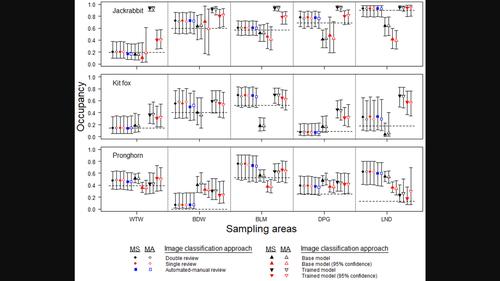当前位置:
X-MOL 学术
›
Remote Sens. Ecol. Conserv.
›
论文详情
Our official English website, www.x-mol.net, welcomes your
feedback! (Note: you will need to create a separate account there.)
Efficacy of machine learning image classification for automated occupancy-based monitoring
Remote Sensing in Ecology and Conservation ( IF 3.9 ) Pub Date : 2023-07-10 , DOI: 10.1002/rse2.356 Robert C. Lonsinger 1 , Marlin M. Dart 2 , Randy T. Larsen 3 , Robert N. Knight 4
Remote Sensing in Ecology and Conservation ( IF 3.9 ) Pub Date : 2023-07-10 , DOI: 10.1002/rse2.356 Robert C. Lonsinger 1 , Marlin M. Dart 2 , Randy T. Larsen 3 , Robert N. Knight 4
Affiliation

|
Remote cameras have become a widespread data-collection tool for terrestrial mammals, but classifying images can be labor intensive and limit the usefulness of cameras for broad-scale population monitoring. Machine learning algorithms for automated image classification can expedite data processing, but image misclassifications may influence inferences. Here, we used camera data for three sympatric species with disparate body sizes and life histories – black-tailed jackrabbits (Lepus californicus), kit foxes (Vulpes macrotis), and pronghorns (Antilocapra americana) – as a model system to evaluate the influence of competing image classification approaches on estimates of occupancy and inferences about space use. We classified images with: (i) single review (manual), (ii) double review (manual by two observers), (iii) an automated-manual review (machine learning to cull empty images and single review of remaining images), (iv) a pretrained machine-learning algorithm that classifies images to species (base model), (v) the base model accepting only classifications with ≥95% confidence, (vi) the base model trained with regional images (trained model), and (vii) the trained model accepting only classifications with ≥95% confidence. We compared species-specific results from alternative approaches to results from double review, which reduces the potential for misclassifications and was assumed to be the best approximation of truth. Despite high classification success, species-level misclassification rates for the base and trained models were sufficiently high to produce erroneous occupancy estimates and inferences related to space use across species. Increasing the confidence thresholds for image classification to 95% did not consistently improve performance. Classifying images as empty (or not) offered a reasonable approach to reduce effort (by 97.7%) and facilitated a semi-automated workflow that produced reliable estimates and inferences. Thus, camera-based monitoring combined with machine learning algorithms for image classification could facilitate monitoring with limited manual image classification.
中文翻译:

机器学习图像分类在基于占用情况的自动化监控中的功效
远程摄像机已成为陆地哺乳动物广泛的数据收集工具,但对图像进行分类可能是劳动密集型的,并且限制了摄像机在大规模种群监测中的实用性。用于自动图像分类的机器学习算法可以加快数据处理速度,但图像错误分类可能会影响推理。在这里,我们使用了三个具有不同体型和生活史的同域物种的相机数据——黑尾长耳大野兔(Lepus californicus)、套件狐狸(Vulpes Macrotis)和叉角羚(Antilocapra americana)——作为模型系统来评估关于占用率估计和空间使用推断的竞争性图像分类方法。我们对图像进行分类:(i)单次审查(手动),(ii)双重审查(由两名观察者手动),(iii)自动手动审查(机器学习剔除空图像并对剩余图像进行单次审查),( iv) 将图像分类为物种的预训练机器学习算法(基础模型),(v) 仅接受置信度≥95% 的分类的基础模型,(vi) 使用区域图像训练的基础模型(训练模型),以及( vii) 训练后的模型仅接受置信度≥95% 的分类。我们将替代方法的物种特异性结果与双重审查的结果进行了比较,这减少了错误分类的可能性,并被认为是最接近事实的结果。尽管分类成功率很高,但基础模型和训练模型的物种级错误分类率足够高,足以产生与跨物种空间利用相关的错误占用估计和推论。将图像分类的置信度阈值提高到 95% 并不能持续提高性能。将图像分类为空(或非空)提供了一种合理的方法来减少工作量(减少 97.7%),并促进半自动化工作流程,从而产生可靠的估计和推断。因此,基于摄像头的监控与用于图像分类的机器学习算法相结合可以促进有限的手动图像分类的监控。
更新日期:2023-07-10
中文翻译:

机器学习图像分类在基于占用情况的自动化监控中的功效
远程摄像机已成为陆地哺乳动物广泛的数据收集工具,但对图像进行分类可能是劳动密集型的,并且限制了摄像机在大规模种群监测中的实用性。用于自动图像分类的机器学习算法可以加快数据处理速度,但图像错误分类可能会影响推理。在这里,我们使用了三个具有不同体型和生活史的同域物种的相机数据——黑尾长耳大野兔(Lepus californicus)、套件狐狸(Vulpes Macrotis)和叉角羚(Antilocapra americana)——作为模型系统来评估关于占用率估计和空间使用推断的竞争性图像分类方法。我们对图像进行分类:(i)单次审查(手动),(ii)双重审查(由两名观察者手动),(iii)自动手动审查(机器学习剔除空图像并对剩余图像进行单次审查),( iv) 将图像分类为物种的预训练机器学习算法(基础模型),(v) 仅接受置信度≥95% 的分类的基础模型,(vi) 使用区域图像训练的基础模型(训练模型),以及( vii) 训练后的模型仅接受置信度≥95% 的分类。我们将替代方法的物种特异性结果与双重审查的结果进行了比较,这减少了错误分类的可能性,并被认为是最接近事实的结果。尽管分类成功率很高,但基础模型和训练模型的物种级错误分类率足够高,足以产生与跨物种空间利用相关的错误占用估计和推论。将图像分类的置信度阈值提高到 95% 并不能持续提高性能。将图像分类为空(或非空)提供了一种合理的方法来减少工作量(减少 97.7%),并促进半自动化工作流程,从而产生可靠的估计和推断。因此,基于摄像头的监控与用于图像分类的机器学习算法相结合可以促进有限的手动图像分类的监控。































 京公网安备 11010802027423号
京公网安备 11010802027423号